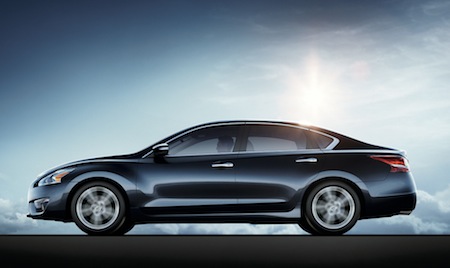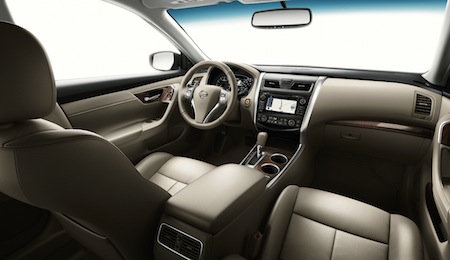2013 Nissan Altima Mid-Size Game Changer
- May 25, 2012
- Chevrolet, Ford, Honda, Hyundai, More Categories...
- Posted by George Peterson
- Comments Off on 2013 Nissan Altima Mid-Size Game Changer
Going on sale in July 2012, the new Nissan Altima joins the most competitive car class in the market. Representing the second largest car segment (after small cars), the mid-size car class is critically important to each manufacturer in the class; volume, profits and image are on the line.
It is hard to believe that the AutoPacific 2010 President’s Award Winner, the 2011 Hyundai Sonata, is about to be the oldest major competitor in the class. The 2013 Nissan Altima joins the new Toyota Camry (new for the 2012MY) and Chevrolet Malibu (2013 Eco model is on the market now) and awaits the launches of the upcoming 2013 heavyweights – Honda Accord and Ford Fusion in Fall 2012.
First seen at the 2012 New York International Auto Show in April, the Altima drew “WOWs” from the media at its unveiling. The management of some competitors gulped and looked a bit nervous. Most were very complimentary; the new Altima has gone upscale in a big way without adding much to its price tag.
Traditionally, the mid-size car class has been noted for its relatively bland styling. That changed with the launch of the 2011 Sonata in early 2010 where over half of the buyers indicated that exterior styling was extremely important in their selection of the car. Sonata’s swoopy styling broke the mid-size car mold. The 2011 Kia Optima that followed the Sonata is strikingly handsome in its own Euro-Korean way. Toyota stayed very conservative with its new 2012 entry and Honda is rumored to have continued its very conservative streak with the next generation Accord coming this fall. The 2013 Ford Fusion is another game changer in the mold of Sonata and Optima, but even with Fusion’s advanced styling, Altima may have pushed the envelope the farthest. Nissan calls it “Altimaness”.
Styling Turns Heads in a Good Way Altima is very attractive and head turning. It has just enough voluptuousness accented by the appropriate amount of chrome bling to give the car a modern distinctive look. Nissan has abandoned the slightly downscale front end styling with the vertical center character of the previous generation Altima in favor of a grille that is more Infiniti than Nissan. The bodyside is sculptured with a flowing character line accenting the front wheel opening, dipping through the front door and rising to a subtly muscular rear quarter panel. The DLO (daylight opening – side window surround) is highlighted by a chrome surround that at-a-glance gives the Altima a 4-door hardtop aura.
Up-to-Date Interior – Nicely Done The interior comes across as more upscale than most mid-size entries. There are faux Alcantara door trim panel inserts with the same material on the center console lid. The overall material selection is top-notch but you wonder why (other than saving $) a hard plastic instrument panel upper was specified. When you get leather seats, the leather is perforated – a nice touch. The instrumentation is easy to read with a digital readout in the instrument cluster between the tach and speedo. The center stack is easy to understand, but the navigation screen seems a bit small (given the very large screens some entrants are adopting these days) and the graphics less eye catching than what is currently out there.
Driving Altima Feels Like a Bigger Car The Altima has the feel and substance of a car from a higher class. It feels very substantial and firmly planted to the road. All Altimas get Nissan’s next generation Xtronic CVT (continuously variable transmission). Nissan has widely committed to CVTs and with that level of commitment they had better be good. The CVT in the Altima is very seamless and seldom reminds you of the rubber-bandy feel of many past CVTs. Altima has two engines. The 2.5L 4-cylinder will be purchased by about 90% of Altima buyers. The 4-cylinder has 182-horsepower and 180 lb-ft of torque (Hyundai Sonata has 198HP). The optional 3.5L V6 is Nissan’s vaunted VQ V6 long a top-rated powerplant. The VQ has 270HP and 258 lb-ft of torque (the Sonata 2.0L 4-cylinder turbo has 274HP).
The 4-cylinder Altima is a great choice for day-to-day driving and it achieves a highway fuel economy rating of 38 miles per gallon. This is quite an achievement for a non-hybrid mid-size entry. This fuel efficiency was gained through reducing the weight of the car, upgrading the CVT through 70% new components and tuning, better aero, electric power steering and a smart alternator. These are the sorts of actions we will be seeing more of by all car makers as they strive to improve fuel economy and meet future fuel economy regulations.
While the 4-cylinder is perfectly adequate for 90% of the driving, the VQ V6 provides the kick in the pants driving thrill enthusiast buyers still covet. Fitted with paddle shifters for the CVT that emulates an 8-speed automatic transmission, the V6 Altima feels more like a luxury sports sedan than a mundane mid-market lump. Admittedly, the paddle shifters will rarely be used, but they are there for the emotional well-being of the driver that occasionally wants to row through the “gears” on the CVT.
Persuasive Pricing The 4-cylinder Altima has a $21,500 base price and can range up to about $27,000 when the SV model with convenience package, navigation and technology package is specified. The V6 starts with the mid-range S package at $25,360 and bumps up to about $32,000 with the SL model with navigation and the technology package. All-in-all this represents an outstanding value for a mid-size sedan whether you select a 4-cylinder base model or the fully loaded SL V6. As a launch incentive, Nissan is offering 3-year/45,000 mile maintenance with the Altima.



